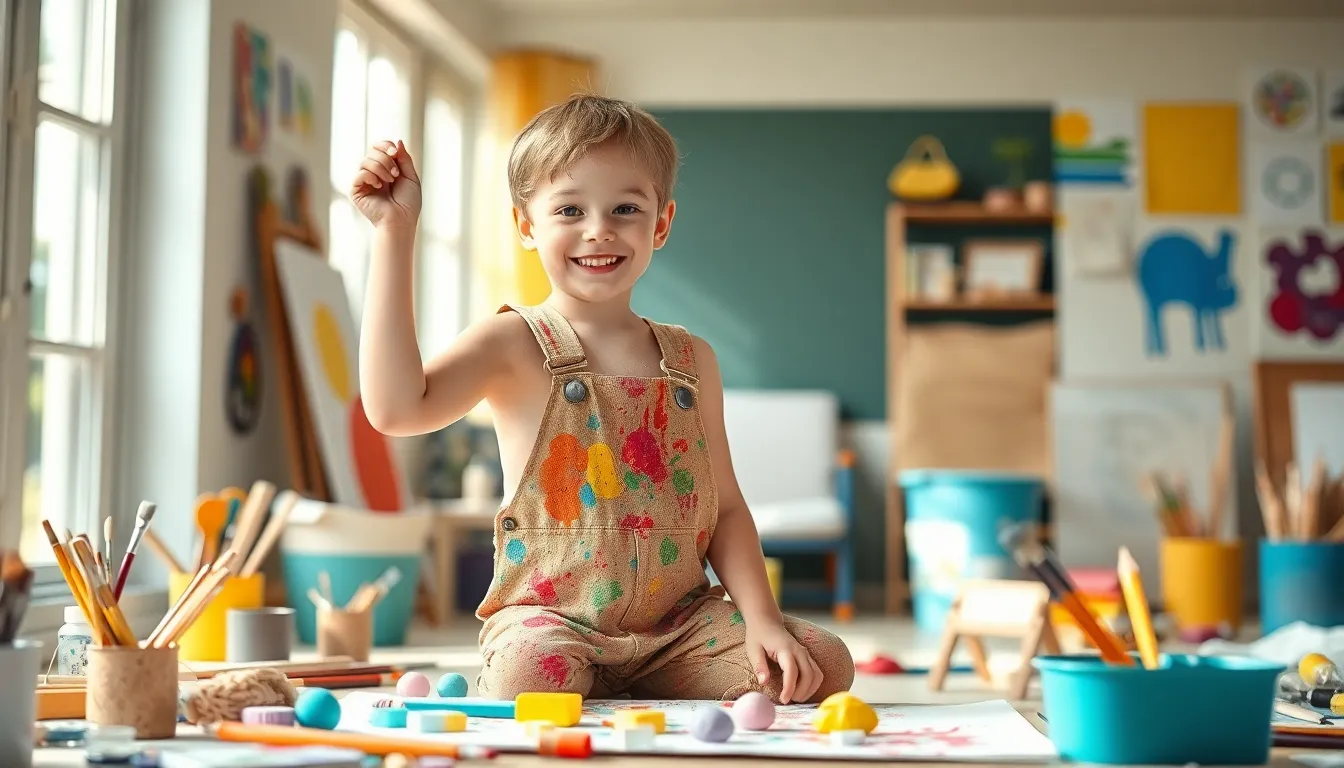In a world where screens often steal the spotlight, it’s time to unleash the magic of creative play. Imagine a realm where cardboard boxes transform into rocket ships and kitchen utensils become powerful wands. Creative play isn’t just child’s play; it’s a gateway to imagination, problem-solving, and even a little bit of chaos—who doesn’t love a good mess now and then?
Table of Contents
ToggleUnderstanding Creative Play
Creative play involves activities that allow individuals to express their imagination and engage in innovative thinking. Both children and adults can experience benefits from creative play, unlocking new ways to solve problems and explore their world.
What Is Creative Play?
Creative play consists of activities where imagination thrives. It encompasses role-playing, arts and crafts, building projects, and storytelling. These activities foster an environment where individuals explore their thoughts and ideas freely. Engaging with various materials and concepts sparks original thoughts and enhances cognitive development. This exploration is fundamental, contributing to improved social skills and emotional resilience.
Benefits of Creative Play
Creative play offers numerous advantages, impacting emotional, cognitive, and social development. It enhances problem-solving skills, helping individuals find alternative approaches to challenges. Imagination grows with creative play, resulting in higher levels of innovation. Additionally, interactions during these activities build teamwork and communication abilities. Engaging frequently in creative play can reduce stress, leading to greater overall well-being. This practice nurtures a positive relationship with creativity, fostering lifelong skills beneficial in various aspects of life.
Types of Creative Play

Creative play encompasses various forms, each contributing unique benefits. Engaging in different activities fosters creativity and imaginative thinking.
Art and Craft Activities
Art and craft activities provide a canvas for expression. Through painting, drawing, or sculpting, individuals can communicate thoughts and emotions visually. Materials like clay, paper, and paint stimulate creativity while enhancing fine motor skills. Children learn to experiment with colors and textures, resulting in unique creations that reflect their personalities. Additionally, sharing these works with others builds confidence and encourages collaboration.
Role-Playing and Imagination
Role-playing taps into imagination, allowing individuals to explore different perspectives. By dressing up or using props, participants create scenarios that enhance social skills and emotional understanding. Such imaginative play promotes empathy as individuals step into various roles, learning to navigate diverse social situations. Storytelling further enriches this form of play, encouraging narrative development and critical thinking. Engaging in role-playing fosters collaboration, as participants work together to develop and act out stories.
Creative Play Tips for Parents
Creative play serves as a powerful tool for nurturing imagination and innovation. Parents can implement various strategies to maximize its benefits for their children.
Encouraging Exploration
Encouraging exploration offers children chances to discover their interests. Providing simple materials like cardboard boxes, fabric scraps, and natural items sparks curiosity. Allowing free access to these resources promotes self-initiated projects. Observing children as they engage in creative play reveals unique insights into their world. Set up themed exploration days around topics like nature or space, igniting enthusiasm for learning. Parents can ask open-ended questions to stimulate thinking, fostering deeper connections with their creations.
Setting Up an Engaging Environment
Setting up an engaging environment cultivates creativity and independence. Design spaces that incorporate various activity zones tailored to different types of play. Dedicate areas for arts, crafts, and storytelling, ensuring children feel invited to explore. Using vibrant colors and accessible storage encourages organization and creativity. Ensure that tools and materials are within reach, promoting autonomy. Create a sensory corner with textures, sounds, and colors to stimulate the senses. Involving children in the setup process nurtures a sense of ownership, encouraging them to dive into their imaginative adventures.
Creative Play Tips for Educators
Creative play can seamlessly integrate into the curriculum, enhancing learning experiences for students. Start by embedding play-based activities in lesson plans to spark engagement. For instance, using storytelling in language arts encourages imaginative expression. Arts and crafts can support subjects like science and math, allowing students to visualize concepts. Incorporating open-ended questions during playtime invites critical thinking, fostering a deeper understanding of the content.
Fostering collaboration among peers is essential in nurturing creative skills. Group projects can stimulate teamwork, allowing students to share ideas and develop social competencies. Designing collaborative art stations promotes joint creativity and communication. Encouraging role-playing in small groups builds empathy and perspective-taking. Implementing peer feedback sessions highlights the value of diverse approaches, reinforcing a sense of community in the classroom.
Embracing creative play can transform everyday moments into opportunities for growth and discovery. By fostering an environment that encourages exploration and imagination, individuals can unlock their potential and develop essential life skills. Whether through arts and crafts or role-playing, the benefits of creative play extend far beyond childhood.
Parents and educators play a crucial role in nurturing this creativity by providing the right tools and space for imaginative activities. As they encourage free expression and collaboration, they contribute to a more innovative and empathetic society. Ultimately, the magic of creative play lies in its ability to connect individuals and inspire a lifelong love for learning and exploration.
